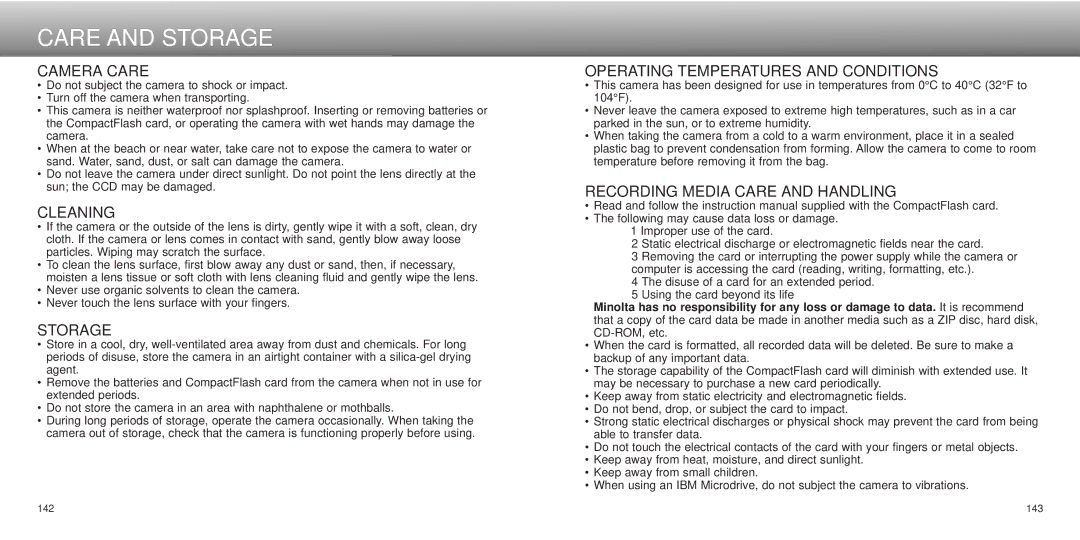
CARE AND STORAGE
CAMERA CARE
•Do not subject the camera to shock or impact.
•Turn off the camera when transporting.
•This camera is neither waterproof nor splashproof. Inserting or removing batteries or the CompactFlash card, or operating the camera with wet hands may damage the camera.
•When at the beach or near water, take care not to expose the camera to water or sand. Water, sand, dust, or salt can damage the camera.
•Do not leave the camera under direct sunlight. Do not point the lens directly at the sun; the CCD may be damaged.
CLEANING
•If the camera or the outside of the lens is dirty, gently wipe it with a soft, clean, dry cloth. If the camera or lens comes in contact with sand, gently blow away loose particles. Wiping may scratch the surface.
•To clean the lens surface, first blow away any dust or sand, then, if necessary, moisten a lens tissue or soft cloth with lens cleaning fluid and gently wipe the lens.
•Never use organic solvents to clean the camera.
•Never touch the lens surface with your fingers.
STORAGE
•Store in a cool, dry,
•Remove the batteries and CompactFlash card from the camera when not in use for extended periods.
•Do not store the camera in an area with naphthalene or mothballs.
•During long periods of storage, operate the camera occasionally. When taking the camera out of storage, check that the camera is functioning properly before using.
OPERATING TEMPERATURES AND CONDITIONS
•This camera has been designed for use in temperatures from 0°C to 40°C (32°F to 104°F).
•Never leave the camera exposed to extreme high temperatures, such as in a car parked in the sun, or to extreme humidity.
•When taking the camera from a cold to a warm environment, place it in a sealed plastic bag to prevent condensation from forming. Allow the camera to come to room temperature before removing it from the bag.
RECORDING MEDIA CARE AND HANDLING
•Read and follow the instruction manual supplied with the CompactFlash card.
•The following may cause data loss or damage.
1 Improper use of the card.
2 Static electrical discharge or electromagnetic fields near the card.
3 Removing the card or interrupting the power supply while the camera or computer is accessing the card (reading, writing, formatting, etc.).
4 The disuse of a card for an extended period.
5 Using the card beyond its life
Minolta has no responsibility for any loss or damage to data. It is recommend that a copy of the card data be made in another media such as a ZIP disc, hard disk,
•When the card is formatted, all recorded data will be deleted. Be sure to make a backup of any important data.
•The storage capability of the CompactFlash card will diminish with extended use. It may be necessary to purchase a new card periodically.
•Keep away from static electricity and electromagnetic fields.
•Do not bend, drop, or subject the card to impact.
•Strong static electrical discharges or physical shock may prevent the card from being able to transfer data.
•Do not touch the electrical contacts of the card with your fingers or metal objects.
•Keep away from heat, moisture, and direct sunlight.
•Keep away from small children.
•When using an IBM Microdrive, do not subject the camera to vibrations.
142 | 143 |
